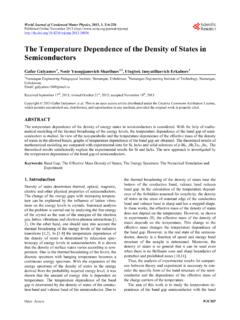Transcription of Handling Inverted Temperature Dependence in Static Timing ...
1 Handling Inverted Temperature Dependencein Static Timing AnalysisALI DASDAN and IVAN HOMS ynopsys, digital circuit design, it is typically assumed that cell delay increases with decreasing voltage andincreasing Temperature . This assumption is the basis of the cornering approach with cell libraries instatic Timing analysis (STA). However, this assumption breaks down at low supply voltages becausecell delay can decrease with increasing Temperature . This phenomenon is caused by a competitionbetween mobility and threshold voltage to dominate cell delay. We refer to this phenomenon astheinverted Temperature Dependence (ITD).
2 Due to ITD, it becomes very difficult to analyticallydetermine the temperatures that maximize or minimize the delay of a cell or a path. As such, ITDhas profound consequences for STA: (1) ITD essentially invalidates the approach of defining cornersby independently varying voltage and Temperature ; (2) ITD makes it more difficult to find shortpaths, leading to difficulties in detecting hold time violations; and (3) the effect of ITD will worsenas supply voltages decrease and threshold voltage variations increase. This article analyzes theconsequences of ITD in STA and proposes a proper Handling of ITD in an industrial sign-off STAtool.
3 To the best of our knowledge, this article is the first such and Subject Descriptors: [Computer-Aided Engineering]:Computer-aided design(CAD); [Register-Transfer-Level Implementation]: Design Aids Automatic synthesis;optimization; [Logic Design]: Design Aids Automatic synthesis;optimizationGeneral Terms: Algorithms, PerformanceAdditional Key Words and Phrases: Static Timing analysis, Temperature Dependence , timingcorners, voltage dependence1. INTRODUCTIONS tatic Timing analysis (STA) is a primary component of both implementationand verification flows for any digital design.
4 Roughly speaking, an STA tooltakes in a circuit and its Timing constraints, computes its performance bounds,compares them against its Timing constraints, and outputs a pass or a performance of a circuit depends on the delays of the paths in the delay of a path in turn depends on the delays of its cells and nets. Net delayThis work was done while both authors were employed at Synopsys, current addresses: A. Dasdan: Yahoo Inc., 701 First Ave., Sunnyvale, CA 94089; I. Hom: Transmeta Corp., 3990 Freedom Circle, Santa Clara, CA to make digital or hard copies of part or all of this work for personal or classroom use isgranted without fee provided that copies are not made or distributed for profit or direct commercialadvantage and that copies show this notice on the first page or initial screen of a display alongwith the full citation.
5 Copyrights for components of this work owned by others than ACM must behonored. Abstracting with credit is permitted. To copy otherwise, to republish, to post on servers,to redistribute to lists, or to use any component of this work in other works requires prior specificpermission and/or a fee. Permissions may be requested from Publications Dept., ACM, Inc., 1515 Broadway, New York, NY 10036 USA, fax:+1 (212) 869-0481, or 2006 ACM 1084-4309/06/0400-0306 $ Transactions on Design Automation of Electronic Systems, Vol. 11, No. 2, April 2006, Pages 306 Inverted Temperature Dependence in Static Timing Analysis 307is out of the scope of this article.
6 Cell (arc) delay is a nonlinear function of manyparameters. To guarantee a pass under any parameter settings in the high-dimensional parameter space, cell delay is usually measured (or characterized)at the corners of the parameter space. Then, these measurements are providedto the STA tool in cell ( Timing ) libraries. These corners are expected to boundthe actual number of corners can be large, sometimes more than a hundred;however, their number has traditionally been restricted to three (which we willuse to simplify our exposition without loss of generality): a fast corner, a slowcorner, and a typical corner.
7 These corners are determined by three parameters:process (P), voltage (V), and Temperature (T). These parameters and cornersare referred to as thePVT parametersandcorners. Together with these threeparameters, two other parameters, input transition time or slew (Sinp) andoutput load capacitance (Cout), are needed to compute the delay of any ITD and Its EffectsTraditionally, in terms of voltage and Temperature , the slow corner of a designis verified at low voltage and high Temperature , and the fast corner is verified athigh voltage and high Temperature . This is due tothe normal patternthat celldelay increases with decreasing voltage and increasing Temperature .
8 However,when voltage is low,a reversal of this normal patternoccurs in that at lowvoltages, cell delay can increase with decreasing Temperature . We will refer tothis phenomenon as theinverted Temperature Dependence (ITD). As a result ofthis inversion, there is one or more crossover voltages at which the inversionoccurs and delay is independent of normal and Inverted Temperature dependences can be seen from thetop and bottom plots in Figure 1, respectively. Each plot shows how the de-lay of a NAND cell from a 90-nm library changes as a function of voltage andtemperature. The same 90-nm library is used for all our results.
9 For voltagedependence, these plots agree: delay increases as voltage decreases. For tem-perature Dependence , these plots disagree due to ITD: the top plot indicates thatdelay increases with increasing Temperature independent of voltage whereasthe bottom plot indicates that delay increases with increasing or decreasingtemperature depending on whether voltage is larger than or smaller than thecrossover voltage of nearly effect of ITD on path delays is more serious, and can be seen fromFigure 2. If the delay of a path follows the normal Temperature Dependence ,it is expected to increase monotonically with increasing Temperature .
10 For ex-ample, the delay curve forVdd= follows this behavior. However, due toITD, the delay of a path mayincrease or decreasewith increasing example, the delay curve forVdd= decreases with increasing temper-ature whereas the delay curve forVdd= first decreases and then increaseswith increasing Temperature . The latter delay curve especially shows that itis nontrivial to determine the Temperature that minimizes a path delay. This,of course, leads to difficulties in hold time analysis due to its reliance on Transactions on Design Automation of Electronic Systems, Vol. 11, No. 2, April A.




![C = Q/ T = dQ/dT [J/deg] - University of Virginia](/cache/preview/a/f/5/8/1/b/f/3/thumb-af581bf37b8258665c1595c6c7b2f7a3.jpg)




